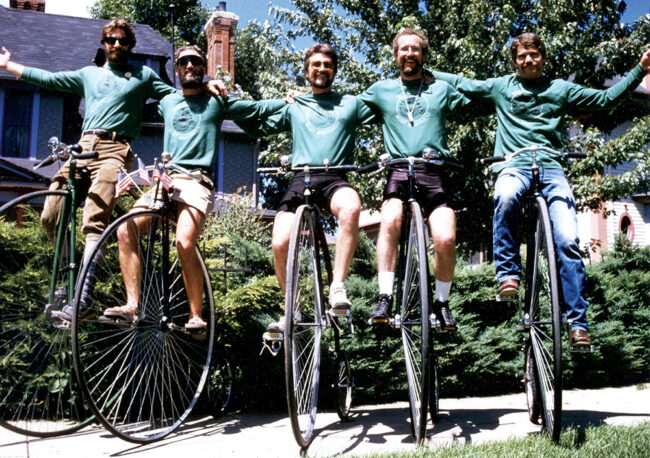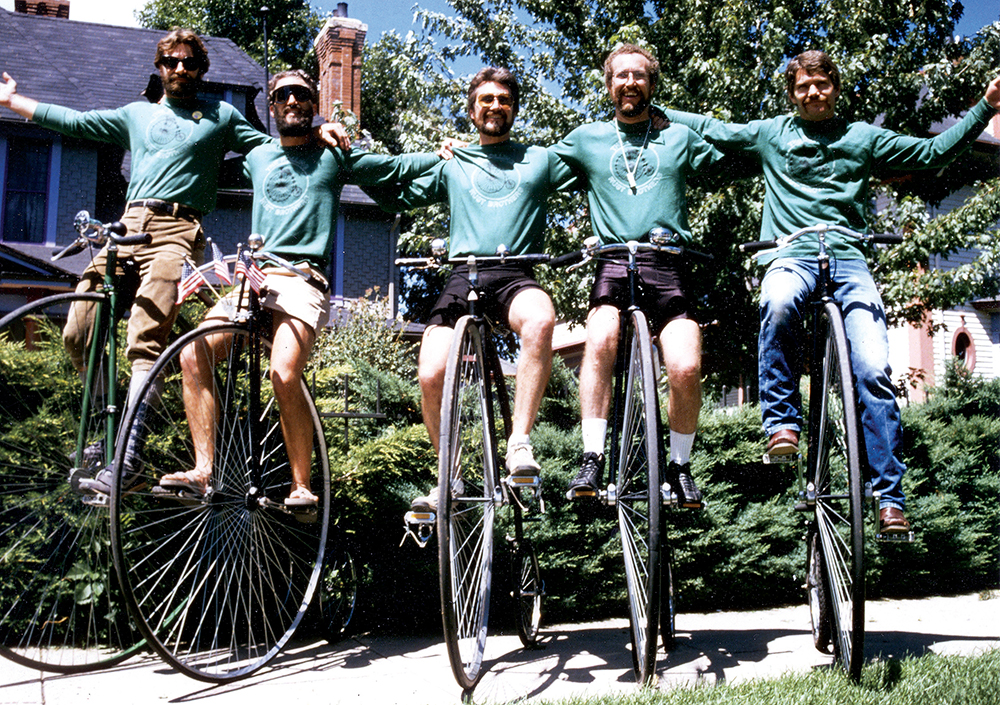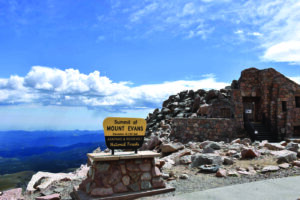THE RURAL AREAS OF COLORADO ARE riddled with mysteries, particularly where dirt roads meet trails winding into the mountains. People who choose to make their lives in this tough and unforgiving environment tend to be private people who have moved out of the city and off the grid for a specific purpose.
Mike Rust was one of those people, having stepped out of the limelight of mountain biking and into the remote San Luis Valley. The mystery of his disappearance, his role as a mountain bike pioneer and the eventual capture of his murderer is documented in the film “The Rider and the Wolf,” recently recognized with an Emmy Award by the Heartland Chapter of the National Academy of Television, Arts and Science.

The film, produced by Salida-based Grit and Thistle Film Co., opens with black-and-white film shots of Rust’s remote homestead, followed by the hauntingly poetic voice of Arkansas Valley legend Curtis Imrie, speaking of young men, sunlight and riding under the sun like birds, carefree. The story of a humble and inventive man who met his untimely demise in the mountains he loved was a mystery that needed uncovering, even though it was, in the words of Imrie, “something that couldn’t be undone.”
I sat down with Nathan Ward, the director of the documentary, and was struck by his humble and inventive nature; an immediate parallel was drawn. Rust’s sister speaks in the film about Rust’s choice of lifestyle, saying, “There was actually a philosophical underpinning to almost every facet of what he believed was right.” In speaking with Ward about the Emmy journey of “The Rider and the Wolf,” I was struck by the same sensation. The goal was to find out what happened to Rust; the Emmy was an afterthought.
Jerry Braden, a rancher living in the San Luis Valley notes that people who choose the remote lifestyle “had better have the backbone to stand up to the plate.” The filmmaking crew consisted of Ward, director/cinematographer; Claude DeMoss, editor/producer; Lyman Smith, final editor; Carlin Walsh, executive producer, and a slew of other locals were all challenged to stand up to the plate.
Initially, this was due to the mystery being unsolved for so long. Rust vanished on the evening of March 31, 2009, and when the festival cut of “The Rider and the Wolf ” premiered at Telluride’s MountainFilm Festival in 2015, Rust had been missing for six years. It was a completely cold case. As the project progressed, the team dumped into the project tens of thousands of dollars, endless hours of work and miles of toil through the Valley with Rust’s family members in an attempt to bring to life the story of this Mountain Bike Hall of Fame cyclist and innovator.
“It was completely a community effort, close to a hundred people worked on different aspects of this film over the years,” explained Ward. “We didn’t know much at the beginning, but we knew a lot more when we finished” — not just more about the mystery of Michael Damian Rust but about the Wild West environment of the San Luis Valley, the people who lived there and how Rust had tapped into his love of biking to impact those around him.
Originally, Ward says, the film was an attempt to solve this cold case. He brought the idea to other filmmakers but couldn’t get anyone to make it. It seemed unfortunate that a member of their own community had gone missing but no one seemed to care to dig deeper. “Eventually we just decided to make the film ourselves.”
It took three years, but once complete, the first version of the film was shared widely throughout Central Colorado. “We needed to make some noise and get people talking about Mike’s disappearance again,” Ward pointed out. They used community screenings, stories on public radio, magazines, newspaper stories and even coverage of the story in the rural electric co-op newsletter. Anyone in the SLV who had electricity and means to tune in likely heard and reheard the story of Rust’s strange vanishing.
Through the intentional spread of the documentary, “The Rider and The Wolf ” won awards at film festivals in the U.S. and abroad over the years. It wasn’t until the mystery had been solved that Ward and DeMoss thought to enter it into a larger award platform — the Emmy Awards.
Margaret Mead stated, “A small group of thoughtful, committed citizens can change the world. Indeed, it’s the only thing that ever has.” With a similar sentiment, Ward notes that the original goal was just to tell Rust’s story then to finish the film despite the many challenges that arose. However, when information came to light identifying the location of Rust’s body and the name of the killer, Ward sat in the Saguache County Courthouse with the Rust family during the trial to listen to testimony and gather additional information about what happened.
In working so closely with the family throughout the process, he understood their number one goal was to find out what happened to their brother. So with the mystery solved, they discussed how to edit the film, adding a long-awaited resolution to the mystery of this Hall of Fame mountain biker turned SLV recluse. Ward and company finished the film by changing the ending to tell that Rust’s body had been found and his killer sentenced to life in prison.
Ward readily admits that, without the members of the film crew, the Rust family, Rust’s friends and all the other people in the community who pitched in to help, the film wouldn’t have come out. “Without any of them, it just couldn’t have happened.”
The first challenge to winning the Emmy was getting the film to be nationally recognized, which meant getting the film on one of the bigger television networks. “The Rider and the Wolf ” was screened by Rocky Mountain PBS, which made it eligible to be entered into the Emmy Award competition. From many entries, judges chose six finalists in the Topical Documentary category, and the Grit and Thistle production was chosen as the winner.
This was Ward’s third Emmy nomination and his first win, the first two for cinematography. However, he was traveling at the time and said he “forgot to even watch the thing.” The ceremony was streaming online, and upon arriving at a hotel close to midnight,
Ward describes pulling up the livestream on his phone in a shuttered and darkened room to find out that he had won. Of course, he roused his family and celebrated not only the win, but the sense of justice for the family and friends of Mike Rust.
Ward continues to uncover truth, having just completed documenting and filming an archeological dig near Durango where a 1,200-year-old Puebloan site was discovered in the path of a highway project. He has a passion for covering water rights in Colorado, explaining that those waters are “under attack.”
Salida and the surroundings are far from any film center, so he clarified that he tends to take projects as they come. With a rueful chuckle, Ward recalls that, by the time “The Rider and the Wolf ” was completed, they had sold much of their equipment, including their cinema camera in order to finance finishing the film. “The Rider and the Wolf ” can be watched for free at vimeo.com/gritandthistle.
Starr Hill was raised off the grid in tipis and old mining cabins between Fairplay, Como, Hartsel and Leadville. Now a teacher, she is raising a family of her own and working on a memoir of lessons she learned growing up off the grid.



